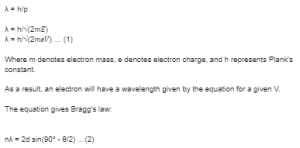The Davisson-Germer experiment confirmed deBroglie’s earlier hypothesis by demonstrating the electron’s wave nature. It was a significant step forward in developing quantum mechanics because it established a firm experimental foundation for wave-particle duality. The Bragg diffraction law had been used before for x-ray diffraction, but this was the first time it had been used for particle waves.
The Davisson and Germer experiment
Davisson and Germer designed and built a vacuum apparatus to measure the energies of scattered electrons from a metal surface. Electrons accelerated from a heated filament were allowed to strike a nickel crystal metal.
The electron beam was focused on a nickel target to study the angular dependence of scattered electrons. Their Faraday box electron detector was mounted on an arc and could be rotated to observe electrons from various angles. They were taken aback when they discovered that the intensity of the scattered electron beam had a peak at certain angles. Using this peak, which indicated electron wave behaviour, Bragg’s law could be used to calculate lattice spacing in the nickel crystal.
The experimental data above, which Davisson’s article, shows repeated peaks of scattered electron intensity as the accelerating voltage increases. This data was collected from a specific scattering angle. Using Bragg’s law, the de Broglie wavelength expression and the kinetic energy of the accelerated electrons are used to calculate the relationship.
Electron deflection and scattering by the medium are thus avoided.
The following are the main components of the experimental setup:
- An electron gun is a Glass tube that emits electrons via thermionic emission when the filament is heated to a particular temperature.
- Electrostatic particulate accelerator: Particles are accelerated using oppositely charged plates at a known potential (positive and negative plate).
- Collimator: The gas pedal is housed within a cylinder with a narrow corridor for electron density parallel to its axis. Its purpose is to prepare an electron beam that is narrow and straight (collimated) for acceleration.
- The goal is to find a Nickel crystal. The electron beam is fired normally on the Nickel crystal. The crystal is designed to continue to rotate around a central axis.
- A detector collects the types of radiation from the Ni crystal. The sensor can be moved in a semi-circular arc.
- It’s worth noting that particles other than electrons can be demonstrated to have a wave nature. Particles including neutrons and alpha particles are also associated with waves and diffracted when dispersed by suitable crystals. Electron diffraction studies were indeed extremely useful for studying crystal structures.
- One of the properties of waves is diffraction. When waves collide with something, they bend around the edges of the obstacle. The bending of waves is known as diffraction. The wavelength of the wave determines the amount of bending.
Diffraction gratings are used to study light diffraction.
Diffraction gratings cannot diffract X-rays or de Broglie waves of electrons because their wavelengths (on the order of 10–10 m) are much shorter than light waves. X-rays and electron de Broglie waves have wavelengths comparable to the distance between atomic planes in a crystal. As a result, crystals that serve as three-dimensional gratings are used for diffraction.
The wavelength can also be calculated using the de Broglie equation (7.18) for V = 54 V.
This value is very close to the wavelength of 1.65 observed experimentally. As a result, de Broglie’s hypothesis about the wave nature of moving particles is directly confirmed by this experiment.
The de Broglie equation and Bragg’s law can be linked as follows:
We can deduce the following from the de Broglie equation:

X-ray diffraction experiments had already determined the value of d. As a result, we can find the wavelength of the waves that produce a diffraction pattern from an equation for various values of
conclusion:-
In the above article, Davisson and Germer experiment is explained. This experiment confirmed deBroglie’s earlier hypothesis by demonstrating the electron’s wave nature. The experiment shows repeated peaks of scattered electron intensity as the accelerating voltage increases. This data was collected from a specific scattering angle.
 Profile
Profile Settings
Settings Refer your friends
Refer your friends Sign out
Sign out






